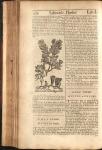This chapter hasn't been proofread yet.
I. The Names. It is called in Greek, Kiro- % JL μ<τί& cipfiw: In Latin, Cistus foemina : and in English, Female Cistus, or Sage Rose.
II. fhe Kinds. Parkinson makes eight several kinds of the Female Cistus : but two of them are Chiefly nourished up in our Gardens, viz. Cistus foemina,'The Female Cistus, specially so called. 2. Cistus Annuus, The Annual or Yearly Cistus.
III. The Descriptions. The first female Cistus. has a woody Root like to the former, from whence grows a kind of shrub, lower and smaller than it, having blackish Branches, less woody, and not so brittle as the Male. The Leaves are somewhat rounder and greener, but a little hard and rough withal, growing in the same manner upon the Branches, as the other, by Couples. The Flowers grow at the tops of the Branches like to the Male kind, consisting of five Leaves, but somewhat lesser, and wholly white, with yellow threads in the middle, as soon fading, and of as little Scent as the other, but the Heads and Seed are somewhat larger.
IV. The second, or Annual Cistus, his a small woody Root, which perishes as soon as its Seed time is past 5 for the Plant endures but a Year, and therefore requires you to Sow it every Year, if you will have it : From this Root rise up strait, but slender hard Stalks, set here and there confusedly with long and narrow greenish Leaves, very like unto the Leaves of the Gum-Cistus, being a little clammy withal. At the tops of the Stalks, and at the Joints with the Leaves, stand two or three pale yellow Flowers, consisting of five Leaves apiece, with a reddish spot, near the bottom of every leaf of the Flowers, which as soon fades as any of the former. The Flowers being past, small three-square Heads follow after, which contain within them small Seed like to the Female kind, but somewhat paler or yellower.
V. The Places. The first grows naturally in hot Countries, as Spain, Portugal, Italy, Languedock The second in Colder Countreys, as Germany, Bohemia, Friefland; and with us they are both brought up in Gardens.
VI. The Times. They Flower in the Summer Months, as June, July and August, and their Seed ripens in the mean Season.
VII. The Qualities, Specification, Preparations, and Virtues, are the lame with the Dwarf Cistus, so that no more need be said of them here.
Botanologia, or The English Herbal, was written by William Salmon, M.D., in 1710.

 Page 224
Page 224